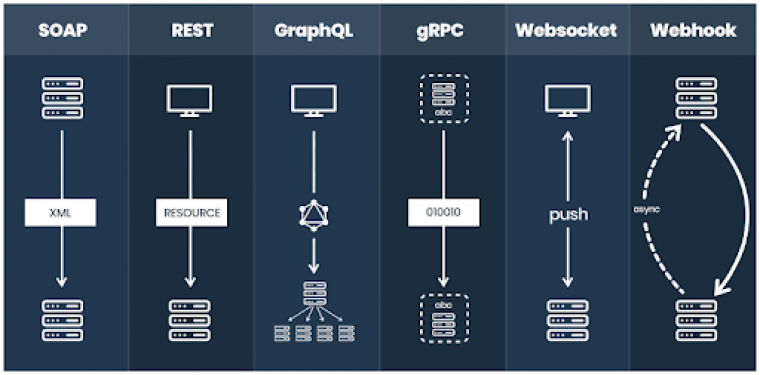The Top 6 API Architectures, everything you need to know!
REST, SOAP, GraphQL, gRPC, WebSocket, Webhooks: Features, Advantages and Disadvantages
- Author: Alessandro Mollicone
- //
- Date: 25/03/2024

REST, SOAP, GraphQL, gRPC, WebSocket, Webhooks: do you know how they work? And are you aware that choosing a specific API architecture can impact the efficiency, adaptability, and maintainability of an application?
Each architecture style has its own philosophy and influences how data transmission, communication, and security are handled. In today's article, we will discuss how they function and how choosing a specific API architecture can impact the efficiency, adaptability, and maintainability of an application.
1. REST
REST is now the most widely used architecture because it offers flexibility, simplicity, scalability, maintainability, and compatibility with web technologies. It utilizes HTTP methods, and its stateless nature and cache support ensure scalability, while resource identification based on URIs ensures structural integrity. It's often used between front-end clients and back-end services and is chosen by services with billions of users like YouTube or Twitter.
However, REST is not always the best choice for projects involving real-time data exchange as it's primarily based on request-response interactions and is challenging to use when retrieving related data is complex and inefficient.
2. SOAP
SOAP is a mature, stable architecture characterized by its dependence on XML. It's widely used in sectors where security and reliability are priorities, such as financial services and payment gateways. The downside of this architecture can emerge for lightweight mobile applications or rapid prototypes due to its complexity and verbosity. It's not scalable and performant; for example, it doesn't support caching or statelessness.
3. GraphQL
GraphQL is an excellent solution that combines flexibility and efficiency and can handle complex data. GraphQL is not just an architecture but also a query language. Unlike REST, it works with a single endpoint and allows accessing exactly the desired data through a single query. GraphQL was developed by Facebook to efficiently and precisely handle billions of data and is used by companies like GitHub and Shopify.
The downside of this architecture is complexity, the need to learn a new syntax and logic, inadequate error handling (always returns HTTP status code 200, even if there are errors). Additionally, GraphQL doesn't support caching by default.
4. gRPC
gRPC is a modern architecture that offers high performance, uses protocol buffers, and ensures compatibility with different programming languages. It's often used for microservices architectures to handle large amounts of inter-service communication. It supports complex operations like streaming and encryption and is chosen for these reasons by companies like Netflix.
However, gRPC has limited browser support and is complex because it requires generating protocol buffer files.
5. WebSockets
WebSockets enable bidirectional and real-time connections between clients and servers, ensuring low latency and instant and continuous data exchange. It doesn't require headers or cookies for each message. It's chosen for applications where real-time updates are crucial to ensure a positive user experience, such as live chats and real-time games. However, WebSocket is not supported by older browsers and doesn't guarantee maximum security (e.g., it doesn't use encryption or authentication).
6. Webhooks
Webhook is a scalable, simple, and easy-to-use architecture based on events. It's a way for servers to send messages to clients when something happens, using HTTP callbacks or POST requests to send payloads with event information. The Webhook architecture is used, for example, by GitHub, to notify other systems whenever a new commit is made.
Webhook is not recommended when synchronous communication or immediate response is critical.
Summary of Each API Architecture's Characteristics
In the following table, we provide a summary of the advantages and disadvantages of each individual API solution:
| API STYLE | PROS | CONS | USE CASES |
| REST | Flexibility, simplicity, scalability, and compatibility with web technologies | Does not involve queries and does not support complex operations | Chosen by web services like YouTube and X (Twitter) |
| SOAP | Security, stability, and maturity | Complexity, verbosity, and does not support caching or statelessness | Financial services and payment gateways |
| GraphQL | Flexibility and efficiency | Complexity, new syntax and logic, inadequate error handling | Used by Facebook, GitHub, and Shopify |
| gRPC | Support for complex operations and compatibility with different programming languages | Limited browser support and complexity for generating protocol buffer files | Used for streaming services like Netflix |
| WebSockets | Low latency and instant and continuous data exchange | Not supported by older browsers and does not guarantee maximum security | Online gaming platforms and live chat |
| Webhooks | Scalable, simple, and easy to use | Not efficient when synchronous communication or immediate response is required | Github uses for commit notifications |
So, What's the Best API Architecture?
There isn't a one-size-fits-all best architecture; however, there are characteristics, strengths, and weaknesses. Some of these architectures can also interact; for example, GraphQL can be built on top of REST services. Therefore, it's useful to select the architecture based on the specific needs and characteristics of the project to which it will be applied.